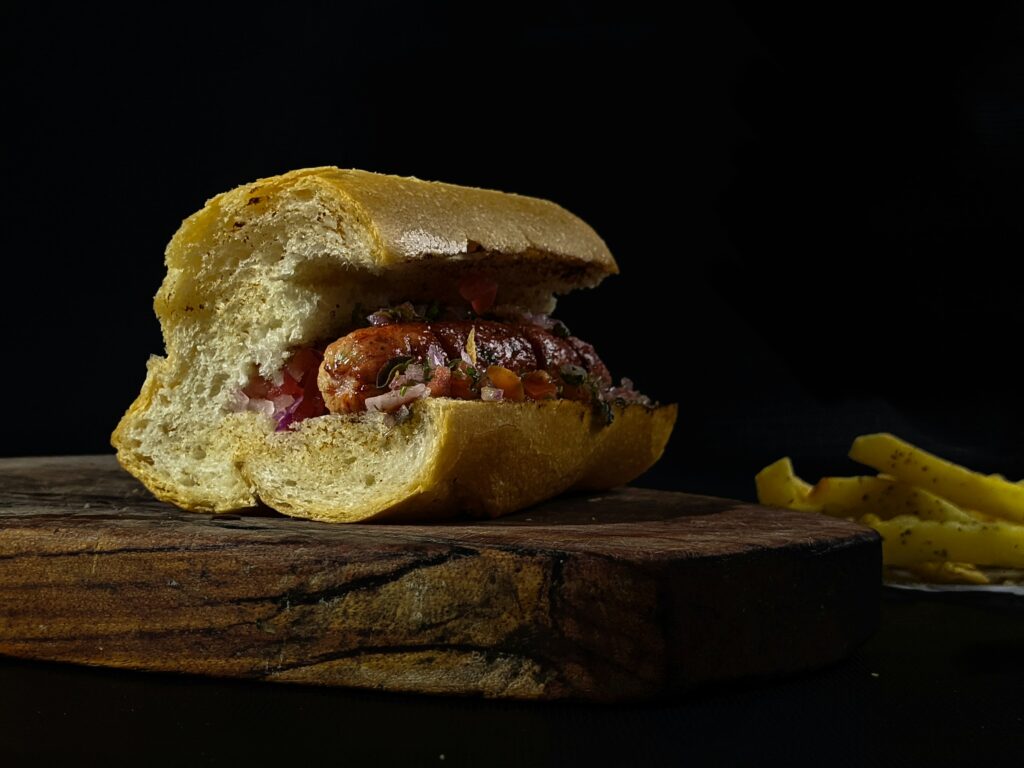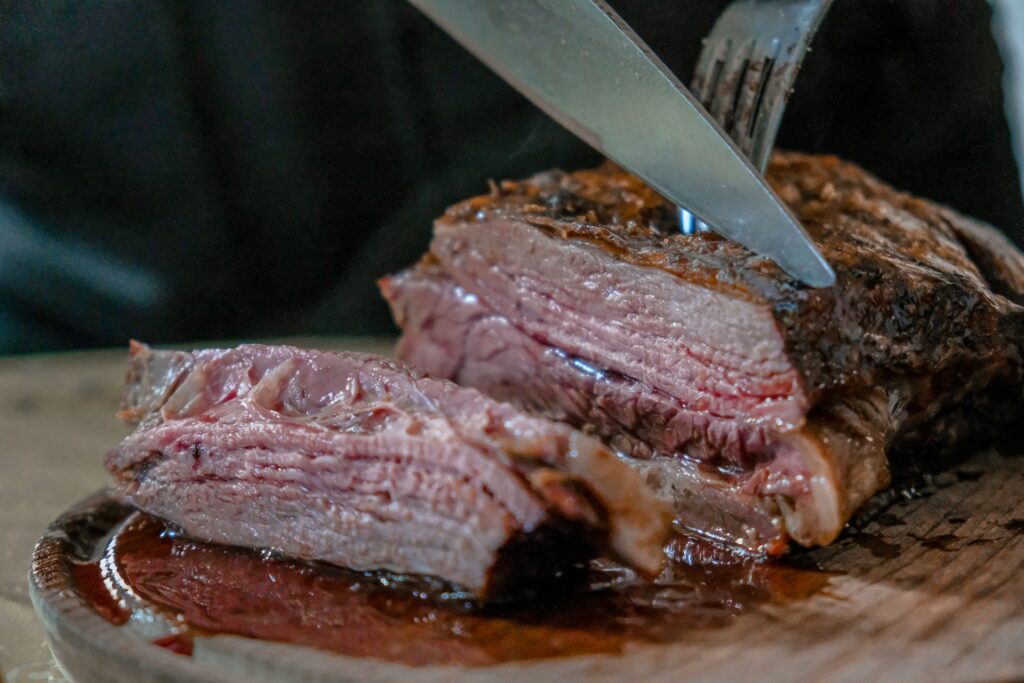Cold cuts, chorizo, blood sausage, sweetbreads, provoleta, meat, chicken, bondiola, wine and even dessert. How to enjoy an Argentine asado with so many delicious things to eat?
Many foreigners come to Buenos Aires with one purpose: to enjoy an Argentine asado from beginning to end. But as you have probably realized, the roast is not made up of a single cut of meat. To put it directly: we Argentines eat even the viscera of the cow.
Therefore, this article will give you an order to follow when enjoying an Argentine asado. That is, what to start with, drinks to accompany it and, of course, the main course: roast meat.
The first thing you should do when attending an Argentine asado is to have a big appetite. Don’t doubt it: it is the most important food in Argentina and not for the faint of heart.
Argentine Asado: What is the Order to Follow When Eating?
1. Charcuterie and Cheese Platter (Picada de fiambres y quesos)
The Argentine asado always begins with a platter of charcuterie, cheeses, and breads. This first course, also known as a “cold appetizer,” is meant to whet the diners’ appetites. Sometimes, it’s simply a way to bide time while the asado progresses in its preparation.
If you go to a steakhouse or a restaurant specializing in Argentine grill, it’s likely that you’ll be served some preserves such as eggplants or peppers, spreadable cheese, and artisanal breads. During this stage, it’s common to pair it with an alcoholic aperitif.
2. Empanadas
Whether you’re having an Argentine asado at a restaurant or a home-cooked version, empanadas often make an appearance as a prelude to the main event. Typically, these are beef empanadas, either knife-cut or ground.
They are eaten hot and are usually fried. When you bite into a beef empanada, you’ll taste the juicy fat and meat oozing from inside. Delicious!
3. Drinks
Let’s talk about the drinks that will accompany your Argentine asado. Of course, beverages should be on the table at least by the time the first cuts of meat and offal arrive.
The default drink to accompany an Argentine asado is red wine, in any of its varieties: Malbec, Cabernet Sauvignon, Merlot, Syrah, blend, etc. White or rosé wines are also common, although they don’t pair as well as red wine.
Remember, Buenos Aires is not only the capital of the Argentine asado but also a place where we enjoy the best wines in Argentina.
Additionally, it’s advisable to include non-alcoholic beverages like water (still and sparkling), juices, and sodas to counteract the effects of alcohol and meat on the stomach.

4. Offal (Achuras)
The Argentine asado begins with offal (achuras). You could say they represent 50% of the Argentine asado and are as important as the meat itself.
Chorizo or Sausage
An essential part of Argentine asados. The chorizo is thicker and larger, while the sausage is thinner but longer.
Depending on the restaurant or butcher shop where you buy the chorizo and sausage, the filling may vary in terms of spices and vegetables. You can choose from beef, pork, or a mix of both.
The chorizo can be eaten split in half (you can ask the grill master to prepare it this way for better cooking and less fat), in slices, or in a sandwich, creating the emblematic Argentine choripan.
Morcilla (Blood Sausage)
Morcilla is a sausage made from cooked pork blood, mixed with fat, onion, and other spices, making it an indispensable part of an Argentine asado.
For someone who has never eaten morcilla, the first impression can be misleading. But the flavor and texture of hot morcilla make it delicious.
Although it looks similar to a chorizo, it’s softer and less firm. The black outer casing can be eaten without issues, but it’s tastier when toasted and crispy.
A common practice is to eat morcilla with chorizo and bread. You can scoop out the morcilla filling with a fork and spread it on bread like butter or cheese.
Chinchulines (Small Intestines)
Chinchulines are the small intestines of the cow. They are carefully cleaned inside and optionally boiled to enhance tenderness and reduce elasticity. Some grill masters skip boiling and go straight to marinating with lemon, garlic, spices, and pepper.
They can be eaten with a bit of salt or lemon juice. There are different grilling techniques: either cut into small pieces that turn crispy over the coals or braided before grilling.
Sweetbreads (Mollejas)
Perhaps the most coveted offal among asado enthusiasts. They can be heart or neck sweetbreads, offering a unique combination of flavor and tenderness.
A good grill master ensures that the already delicious sweetbread is not ruined during cooking. They can be eaten with lemon juice or just a pinch of salt.
Kidneys
In an Argentine asado, we also eat cow kidneys. Texture and flavor-wise, kidneys are somewhere between chinchulines and sweetbreads.
They can be grilled whole or sliced, though the latter can cause them to burn or harden.

5. Provoleta
A variant of provolone cheese grilled to perfection. There are two classic ways to cook provoleta: directly on the grill or using a cast-iron skillet, either on the grill or over the coals.
Provoleta is an essential part of an Argentine asado. Enjoy the melted cheese with intense flavor, often forming a delicious crispy crust.
6. Side Dishes for the Argentine Asado
Accompaniments for the Argentine asado are straightforward. While in a restaurant you can choose any side dish, the custom is to opt for either French fries or salads.
Salads
Salads are a great accompaniment to the Argentine asado as they help balance the consumption of fats and proteins. They also complement the fresh taste of vegetables with the hot, hearty meat.
The most recommended salads for an Argentine asado are the classic and arugula with Parmesan cheese (or similar).
What is a classic or mixed salad? It includes tomatoes, onions, and lettuce (purple or green). It’s a light and fresh accompaniment ideal for an Argentine asado.
On the other hand, arugula and Parmesan cheese salad has become very popular for pairing with an Argentine asado, especially for those who tire of the classic salad.
French Fries
For many Argentine asado enthusiasts, French fries are the indispensable side dish. They don’t want vegetables or anything fresh, just crispy, golden, and hot fries to accompany the offal and meat of the asado.
While at a home asado, French fries are typically served in sticks (classic), in a Buenos Aires restaurant or grill house you’ll have many options: sticks, slices, noisette, waffle-cut, cubes, and even with Provençal or cheddar as toppings.
7. Condiments
Before moving on to the meat, it’s essential to mention the condiments that accompany the Argentine asado.
Condiments are used not only with the meat but also with the offal and even the French fries.
There are two main condiments for the Argentine asado. First, chimichurri, a mix of spices (chili flakes, parsley, garlic, oregano, vinegar, oil) with a strong and sometimes spicy flavor. Second, salsa criolla, made with ingredients like onion, pepper, garlic, paprika, tomato, oil, and vinegar, which is fresher than chimichurri.
At any Argentine steakhouse or asado restaurant, you’ll find chimichurri and salsa criolla on your table. Sometimes, liquid Provençal is also offered.
8. Beef (Carne vacuna)
The queen of the Argentine asado. Both foreigners and Argentines bow down to the high quality of Argentine beef, which is hard to find elsewhere in the world. Beef is the star of the Argentine asado, often the first to be placed on the grill. The reason is simple: you can’t cook beef over high heat unless you want a piece of leather that’s impossible to eat.
There are several cuts of beef, some with bones and others with varying amounts of fat. Below are the most common cuts, as well as those you must try.
Short Ribs (Tira de asado o costillar)
This is the most iconic cut for Argentines, though paradoxically, it is not the most ordered by foreigners at steak restaurants. The short ribs are delicious because they are directly attached to the rib bones, giving them a lot of flavor.
Short ribs can come with large or small bones; in the latter case, they are called “asado banderita.” You can eat the meat with cutlery and save the bones for last, using your hands to enjoy the meat, fat, and skin around them. Exquisite.
Flank Steak (Vacío)
The second most demanded cut by Argentines after short ribs. It is known for being flavorful and fibrous, allowing you to enjoy a tender and juicy cut of meat that can also be marinated or stuffed with ingredients like vegetables.
It has a strong flavor and tender texture, though the grill master must respect the long cooking time to prevent it from becoming tough and inedible.
Flank Steak (Matambre)
Cut from the hide and ribs of the cow, this is excellent for grilling over charcoal. It’s one of the most desired cuts for either stuffing or serving straight up.
A tender and soft flank steak is a true delicacy for barbecue lovers. Depending on the type of flank steak, it can be thick or thin, so careful cooking is essential to avoid overcooking.
Tri-Tip (Colita de cuadril)
The variety of ways to prepare tri-tip, especially on special occasions, makes it popular among grill enthusiasts. It’s a boneless cut rich in meat with a small amount of fat visible on the sides.
There are several ways to prepare tri-tip, but it’s recommended to cook it over medium heat, letting a crust form before flipping it to ensure a juicy, tender, and soft result.
Skirt Steak (Entraña)
Argentine grills are famous for skirt steak, a thin, tender, flavorful, and crispy cut usually covered with a thin layer of fat. It’s generally not recommended to include this fat layer because it makes the meat shrink excessively and difficult to share with guests.
In recent years, skirt steak has become a favorite among Argentines due to its easy cooking and delicious flavor.
Sirloin (Bife de chorizo)
One of the most popular cuts for grilling. If you love meat, you must try the sirloin. This Argentine cut is absolutely delicious and one of the country’s most popular dishes. It is usually grilled or pan-fried and served with various sides like potatoes and different salads.
The meat is incredibly tender and flavorful, making it a must-order at steak restaurants or butcher shops if you’re preparing your own asado.
Tenderloin (Lomo)
Tenderloin is one of the cuts most celebrated by foreigners when tasting Argentine beef. Its quality comes from both the grilling process and the care and breeding of the cattle.
It is a perfect cut for the grill, ensuring satisfaction for all diners. It is soft, full of flavor, and tender.

9. Pork (Carne porcina)
If you still have room in your stomach for more Argentine asado, you should know that an important player is missing: pork.
As if beef wasn’t enough to satisfy the average asado fan, Argentines enjoy pork on the grill. Though not as juicy as beef, the combination of fat, gentle cooking, and flavor makes pork a delicious option.
Pork Shoulder (Bondiola)
Pork shoulder is an excellent choice for enjoying a delicious grilled meal. It’s a white meat characterized by a mild, sweet flavor. It’s a low-fat cut that becomes very tender and juicy when cooked over coals.
The trick to grilling pork shoulder is to cook it slowly and turn it at the right moment to ensure even cooking without burning.
Pork shoulder is delicious in a sandwich with some chimichurri.
Pork Ribs (Pechito de cerdo)
Pork ribs are one of the ideal cuts for grilling because they cook quickly and evenly. They are a lean cut with a smooth texture, pink color, and a slightly sweet flavor from the upper chest of the pig.
They are high in protein and low in fat, making them a healthy meat choice. They are also easy to handle and cook because they don’t fall apart or shred.

10. Chicken (Pollo)
Do Argentines grill chicken at an asado? Absolutely! Thighs, drumsticks, and breasts, if not the whole chicken, are often present at an Argentine asado. While not all asado enthusiasts choose chicken when dining out, as beef takes precedence, well-grilled chicken can surprise even those not used to eating this type of meat.
It’s crucial to accompany the chicken with some sauce or liquid seasoning, applied both before and during grilling.
11. An Important Matter: The Doneness of Meat
Argentines are used to eating juicy and red meat. However, not everyone enjoys their meat cooked this way. Some prefer medium doneness, while others insist on well-done meat.
So, how do you tell the grill master how you want your meat cooked? Or better yet, can you choose the doneness of the meat?
First things first: yes, you can choose the doneness, especially for beef. For pork, it is not recommended to eat it rare, and the same goes for chicken.
Here are the three doneness levels:
- Juicy meat: The minimum doneness for meat to be safe to eat. The inside is pink, and cooking juices are released when cut. Suitable for beef but not for pork or chicken.
- Medium cooking point: An intermediate doneness where the meat is not pink or red but remains tender and easy to chew.
- Well-done: The maximum doneness before the meat becomes tough. At this point, the meat is fully cooked but may become hard and difficult to chew.
Dessert
Do you still have room for dessert after an Argentine asado? Not everyone makes it to this stage, but the temptation for something sweet can be strong.
A Hot or Alcoholic Drink
Let’s start with the lightest option: coffee, tea, or a drink. If you have no room or appetite for dessert, you can opt for these choices at both restaurants and home barbecues to avoid being empty-handed.
Ice Cream
A common dessert after an Argentine asado. Being a refreshing option, it can help with digestion without forgoing a dessert.
Restaurants offer everything from classic artisanal ice cream to frozen desserts that include chocolate, cookies, fruits, cream, and even alcohol (liqueur, whiskey, etc.).
Flan
A very popular dessert among Argentines. The combination of eggs, milk, sugar, and caramel makes it irresistible, especially for those with a sweet tooth.
To make it even more indulgent, Argentines often add dulce de leche or whipped cream as accompaniments.
Strawberries and Cream
The combination of strawberries and whipped cream or Chantilly is a foolproof dessert for an Argentine asado.
Some restaurants go a step further by adding not only whipped cream but also ice cream to the strawberries.
Fruit Salad
Looking for a fresh but less calorie-dense dessert than ice cream? Both in restaurants and family barbecues, fruit salad is a celebrated dessert.
The freshness of the fruits is perfect for aiding digestion after all the meat consumed during the asado.

Last Considerations
You’ve seen that the Argentine asado is a gastronomic ritual in every sense of the word. From the preparation and the social gathering around the grill to the “route” or “path” we propose for enjoying all the meat cuts and offal, the Argentine asado is an adventure you can’t miss.
If you truly want to enjoy the Argentine asado in Buenos Aires like a local, follow our roadmap to the letter. You’ll start with the charcuterie, move on to the offal, and finally reach what you’re likely looking forward to the most: the beef.
(Featured Image Source: DEBY RODRIGUEZ/unsplash.com)


